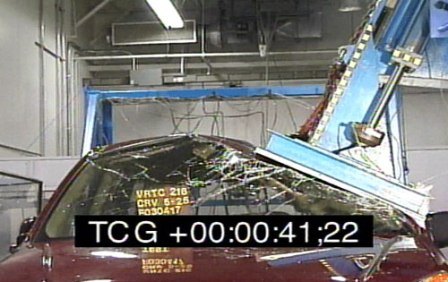IIHS Call for Stronger SUV Roofs Could Increase Roll-over Risk
Current federal regulations require that car and truck roofs support 1.5 times their vehicle's weight. According to The Detroit Free Press, the Insurance Institute for Highway Safety (IIHS) is recommending that this standard be upgraded to 2.5 times the vehicle's weight on the driver's side. The industry-sponsored safety campaigners released a study concluding that the strongest existing SUV roofs reduce the risk of injury by 39 to 57 percent. The Chevy Blazer fared the worst in their roof crush test, while Nissan's X-Terra, Jeep's Liberty and third-gen Ford Explorers scored the highest. (Both the Explorer and the Grand Cherokee showed significant improvement in newer models vs. previous generations.) The new study does not deal with the impact of seat belt use (or lack thereof)– judged by "real world" analysis to have greater impact on rollover deaths than roof strength. Also, as TTAC's Bob Elton pointed out back in '06, reinforcing SUV roofs would raise the vehicle's center of gravity, potentially increasing the likelihood of a rollover. Although the IIHS called for active handling for all SUVs, the laws of physics cannot be ignored– or revoked.
More by Edward Niedermeyer


































Comments
Join the conversation
As a police officer, I saw lots of rolled over Explorers. Never saw one with the roof compromised where the idiot driving it was actually belted in anyway. SUV = tippy beast - don't make it worse. And they still test Chevy Blazers? Was that supposed to be TrailBlazers?
Damn those laws of physics! Always the tradeoffs. The more weight on the roof, the higher the center of gravity. From a Ford brochure's page 35 (showing SUV's), in reference to stability control systems: "Remember that even advanced technology cannot overcome the laws of physics. It's always possible to lose control of a vehicle due to inappropriate driver input for the conditions."
According to NHTSA, the National Highway Traffic Safety Administration, there are approximately 275,000 rollovers in the US every year. Many of those are caused by weather conditions, reckless drivers cutting others off or from evasive efforts dealing with other unexpected obstacles in the road. Rollovers constitute only 3% of all accidents in the US but are responsible for nearly 30% of all auto related deaths (that number of deaths from rollover jumps to nearly 60% of all SUV accidents.) The NHTSA reports that 10,000 people die every year in the US from effects related to rollover accidents. They report that another 24,000 receive catastrophic injury including the largest number of brain and spinal injuries often leading to quadriplegia and paraplegia. According to the IIHS, Insurance Institute for Highway safety, a roof strength of four times the vehicle weight would cut those numbers of lives lost in half: 5,000 American lives a year saved and 12,000 fewer catastrophic injuries every single year. For those concerned about adding weight above the vehicles center of gravity, the Institutes research indicates the effect would be minimal. First by using high strength lighter weight materials and second because whatever minimal added weight may be added is dispersed along the plane between the midpoint of the car and the roof line. (Unlike popular features like sunroofs that can add an average of 35-45lbs at the very highest point of the vehicle.